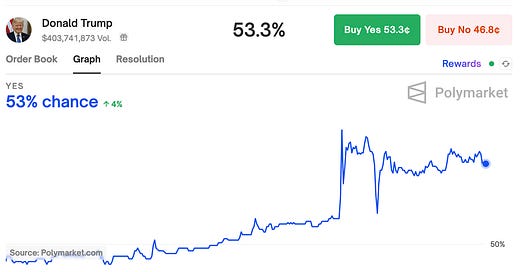On the morning of October 7 there was a sharp increase in the price of the Trump contract on Polymarket that did not seem connected to any new public information, and was not mirrored in other prediction markets:
An astute observer pointed out that the price increase was driven in large part by the activity of a single trader, Fredi9999, who had already accumulated over 7 million contracts and was also betting heavily on Trump to win Pennsylvania. The number of contracts held by this account in just this one market is now close to 11 million, and the funds invested across all markets add up to about $8.4 million:
This trader (or consortium) is adopting a very particular strategy—placing large limit buy orders slightly above the current best bid, effectively setting a floor on the price of the Trump contract. The price is high enough that it doesn’t get outbid, so for long stretches (especially overnight in the US) anyone wanting to bet against Trump ends up trading with this account.
This is true across multiple markets, with large orders currently in place on Trump to win the election (at 53¢), Pennsylvania (at 54¢), Michigan (at 47¢), Wisconsin (also 47¢), and even the popular vote (at 27¢).
You can see that Fredi9999 is the counterparty for virtually all traders betting against Trump, especially overnight, by looking at the activity associated with the account. You’ll see a long, uninterrupted string of trades like the following from a few hours ago:
This is just a small snippet of activity; there are dozens of such entries every hour, with order sizes ranging from a handful to tens of thousands. The bets against Trump are coming from a broad range of accounts but they all encounter the same buyer over long stretches of time.
This strategy is virtually identical to that of a trader who bet about seven million dollars on Romney during the 2012 election cycle, and was a party to almost 23,000 separate trades.
The price moves on Polymarket are not reflected elsewhere, for instance on Kalshi:
Kalshi is a regulated exchange open only to US nationals, with strict restrictions on participation. For instance, the exchange prohibits trading by anyone holding federal or statewide office, staffers or contractors for presidential campaigns, employees of political party organizations and polling outfits, those working at decision desks for major media companies, and all congressional staff.
While such individuals cannot easily trade on Kalshi, they could all trade on crypto-based Polymarket under the cloak of anonymity.
Which of these markets (if any) should one take seriously? And how should one assess market-derived probabilities in relation to forecasts based on major statistical models? I am trying to answer this question empirically based on the methodology described in a recent paper, and implemented for the current cycle in an earlier post. Once there is enough data available I’ll be able to see whether Polymarket is ahead of the rest or simply exhibiting movements that have no real informational basis.
The answer will depend on what is motivating Fredi9999 to trade in this way. There are at least three possibilities.
This could be someone with deep pockets who firmly believes that Trump will win the Rust Belt and the election with it, and wants to accumulate a large number of contracts at prices that appear cheap. Alternatively, it could be someone who wants to have a price impact and make Trump appear to have better prospects than the market would otherwise suggest, in the expectation that this will boost morale and keep donations and volunteer effort flowing. And finally, it could be someone with material inside information that has not yet become public—possibly related to internal polling or forthcoming endorsements—and expects that there will be a major price impact once the information leaks.
In the first two cases, the forecasting accuracy of Polymarket will be compromised, but in the third case it will be enhanced. We will just have to wait and see. But one thing this episode has made clear is that the presence of a regulated exchange like Kalshi—operating as a direct competitor to a crypto-based exchange that is largely beyond the reach of American regulators—provides the general public with a valuable standard of comparison. This is a point I have made previously, and one that I have become increasingly convinced of.







